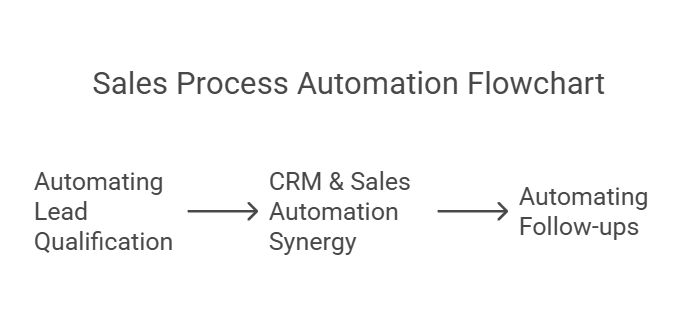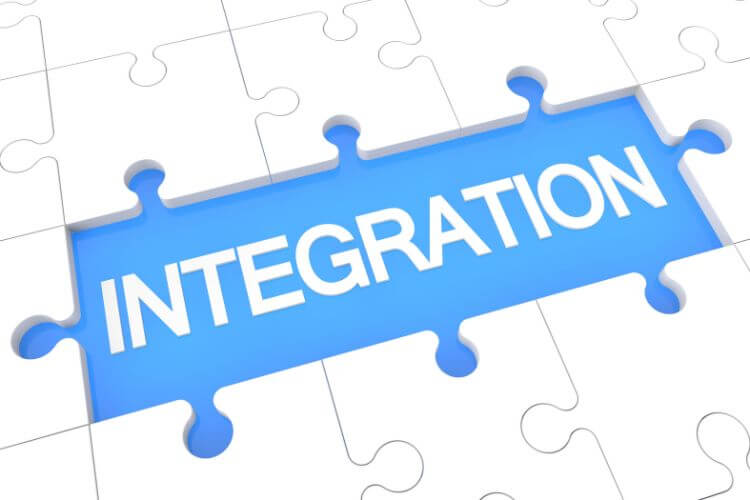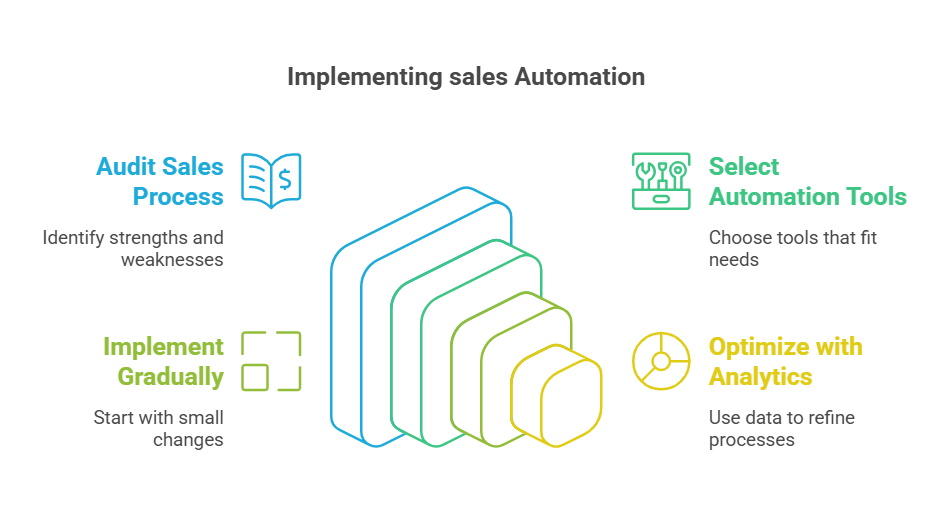In today’s quick-paced B2B SaaS world, automation and cybersecurity also help improve processes. In the technology sector, the advantages of sales automation are key to enhancing sales productivity. Implementing a marketing automation platform can streamline the lead-to-revenue pipeline, enhancing efficiency and driving growth through targeted marketing campaigns while automation reduces manual workload.
1. Why Sales Teams Struggle with Productivity (and How Automation Fixes It)
The Biggest Bottlenecks in Sales Productivity
- Slow lead qualification & response times: Delayed responses can lead to missed opportunities.
- Lack of integration between sales and marketing tools: Disjointed systems hinder seamless operations.
- Sales reps spending excessive time on manual tasks instead of closing deals: Administrative duties can detract from core selling activities.
- Inconsistent follow-up leads to lost opportunities: Without systematic follow-ups, potential deals may fall through the cracks.
How Marketing Automation Solves These Challenges
- AI-driven leads scoring & qualification: Automation software allows prioritization of leads based on potential and engagement, keeping sales teams in touch with high-value prospects and enhancing sales enablement.
- Automated CRM & follow-ups: Functions such as LinkedIn outreach and email drips can keep communication regular without human intervention, which is helpful for sales.
- Real-time intent tracking: Tools that monitor website visits and user activity provide insights into potential customer interests.
- Integrating sales and marketing efforts seamlessly: Unified platforms ensure both teams work cohesively towards common goals.
2. Step-by-Step Guide to Automating Your Sales Workflow

Automating Lead Qualification: The First Step to Faster Sales
- Why manually qualifying leads wastes time & resources: Manual processes are time-consuming and prone to errors.
- Tools to automate lead qualification: Boost sales, such as many marketing automation software. Applications like n8n, HubSpot, rb2b, and Breeze(Earlier Clearbit) will help automate it.
- AI-driven lead scoring to prioritize hot leads: Utilize machine learning algorithms to assess lead quality based on behavior and demographics, like which money page they went, how many pages they visited, etc.
Example:
- Set up rb2b to track anonymous IP visits: This tool identifies companies visiting your site, allowing for targeted outreach.
- Use Clay Enrichment: Use API to pull company data for instant qualification, enhancing the effectiveness of CRM with marketing automation software and driving new sales. Enhance lead profiles with comprehensive data, facilitating informed decision-making and personalization.
CRM & Sales Automation Synergy: Nurturing and Converting Leads Faster
- Why and how automation changes that: Automated systems ensure timely and personalized interactions, increasing the likelihood of conversion.
- Automating email follow-ups for sales efficiency: Timed, customized emails via email marketing keep prospects interested without any human intervention, showcasing the efficiency of sales and marketing automation.
- Integrating CRM & automation tools: Combining platforms like HubSpot, Salesforce, and ActiveCampaign ensures data consistency and streamlined workflows.
Pro Tip: Implement dynamic lead nurturing strategies. For instance, if a lead opens an email but doesn’t respond, trigger a personalized LinkedIn message to re-engage them. You can use tools like Aimfox, Exandi, and many others to do dynamic lead nurturing.
Automating Follow-ups: The Secret Weapon of High-Performing Sales Teams
- How to automate follow-ups without sounding robotic: Use personalized templates and adjust messaging based on lead behavior.
- Tools: Consider utilizing marketing automation tools for better lead management. Platforms like Apollo.io, Smarlead, Instantly, and Reply.io offer features for personalized automation.
3. Reducing Sales Cycle Time with Automation
Why Long Sales Cycles Kill Revenue & How to Fix It
- Average B2B sales cycle: The median length is approximately 2.1 months, for higher ticket size businesses like MSP, Cybersecurity it takes more than 6 months.
- Automating proposal generation & contract signing: Tools like PandaDoc, DocuSign, and Proposify can expedite these processes.
Leveraging AI for Predictive Sales Forecasting
- AI-powered analytics for better decision-making: Predictive models can forecast sales trends, allowing for proactive strategies.
- How predictive modeling helps prioritize high-value leads: Streamline marketing campaigns for better results. AI analyzes patterns to identify prospects with the highest conversion potential, helping the sales manager optimize their approach.
- Best AI-driven sales forecasting tools: Can greatly augment your marketing team’s abilities. Gong.io, Clari, and InsightSquared are platforms with powerful analytics functions for sales and marketing automation.
4. Sales & Marketing Automation Integration: The Missing Link

The Sales & Marketing Alignment Problem
- The sales teams feel their marketing counterparts don’t understand their needs, leading to misaligned strategies.
- How automation creates a seamless lead handoff: Integrated systems ensure that marketing-qualified leads are promptly and accurately transferred to sales teams, enhancing the power of marketing automation.
Setting Up the Perfect Sales-Marketing Automation Stack
- Lead tracking & intent data tools: Utilize platforms like rb2b, Albacross, and Leadfeeder to monitor prospect engagement.
- CRM & marketing automation synergy: Combining tools like HubSpot and Salesforce ensures cohesive operations.
- AI-driven prospecting: Integrate solutions like Apollo.io with AI models and marketing automation tools to enhance personalized outreach.
5. Measuring ROI: Proving That Sales Automation
Key Metrics to Track
- Lead response time: Faster responses often lead to higher conversion rates.
- Lead-to-customer conversion rate: Monitor the percentage of leads that become paying customers.
- Sales cycle length: Shorter cycles can indicate increased efficiency.
6. Common Objections & How to Overcome Them

Will Automation Make Sales Less Personal?
A common fear among sales teams is that automation will remove the human touch from prospect interactions. However, the opposite is true when used correctly.
- Personalization through AI: Automation platforms can dynamically adjust messages based on prospect behavior, ensuring outreach remains relevant and engaging.
- Hybrid approach: Combining automated touchpoints with marketing automation can help improve overall engagement. While human intervention is sometimes necessary, automation allows for a reduction in manual errors in the sales process. At critical stages, keep the conversation authentic.
- Example: A sales team using automation to boost their performance can significantly improve the sales funnel. Follow-ups and appointment scheduling saw a 40% increase in responses while bookings for practices that adopted an online booking system.
We Don’t Want to Change Our Sales Process
Many organizations resist change due to the fear of disrupting existing workflows. However, automation isn’t a one-size-fits-all solution; it requires careful planning and strategy. Enhances sales processes rather than replacing them.
- Start small marketing automation systems: Automate a single step, such as lead qualification or follow-ups, and expand gradually.
- Keep control: Sales teams still oversee interactions while automation handles repetitive tasks.
What If the ROI Isn’t Worth It?
Concerns about cost and effectiveness are common when adopting automation.
- Calculating ROI: Businesses should measure time saved, conversion improvements, and overall revenue growth.
- Example: Companies implementing automation in marketing can reduce overhead costs, offsetting the investment in marketing automation software.
7. Implementing Sales Automation: Your Next Steps

For businesses ready to optimize their sales process, follow these steps:
Step 1: Audit Your Current Sales Process
- Identify inefficiencies: Where do sales reps spend the most time?
- List manual tasks: They can be automated, such as those that can benefit from marketing automation software. Email outreach, CRM updates, or lead qualification.
Step 2: Choose the Right Automation Tools
- Lead qualification & scoring: n8n, rb2b, and Clearbit(Now acquired by HubSpot as Breeze) are examples of automation software that can optimize your marketing efforts.
- CRM & workflow automation: HubSpot, GoHighLevel, Salesforce, ActiveCampaign
- Email follow-ups & outreach: Apollo.io, SmarLead, Instantly, Lemlist, Reply.io
Step 3: Start Small and Scale Gradually
- Automate one process at a time to minimize disruption in marketing campaigns and ensure smooth operations.
- Example: Start with automated follow-ups and expand to CRM syncing and AI-driven lead scoring.
Step 4: Continuously Optimize Based on Analytics
- Monitor KPIs such as the benefits of marketing automation. In marketing and sales, conversion rates, response times, and deal velocity are critical metrics that can be improved through automation.
- Adjust automation workflows based on data insights.
- Conduct quarterly automation audits to refine strategies.
8. FAQ: Common Questions About Sales Automation
1. What’s the best sales automation tool for small businesses?
For small teams, GoHighLevel, HubSpot(Starter Plan) and Apollo.io offer affordable, scalable solutions with built-in CRM and outreach automation.
2. How do I ensure my sales automation doesn’t feel robotic?
Utilize behavior-based triggers to personalize messages. AI-powered tools are able to customize tone and suggestions based on lead interactions, amplifying the abilities of automation systems.
3. Can automation help with outbound sales prospecting?
Yes! AI-driven prospecting tools Tools like Seamless.ai and Cognism can identify ideal leads, enrich data, and automate cold outreach sequences, significantly boosting the sales rep’s productivity.
4. How much does sales automation typically cost?
Costs vary by platform, but most businesses recoup investments through time savings and increased conversions within 3-6 months.
Conclusion
Sales automation is no longer a luxury; it’s a necessity in a competitive market. By automating repetitive tasks, improving lead qualification, and optimizing follow-ups, businesses can boost sales productivity, shorten the sales cycle, and increase revenue. The key is to start small, select the right tools, and measure performance continuously. Organizations that embrace automation effectively can create a scalable, data-driven sales engine that empowers reps rather than replacing them.
